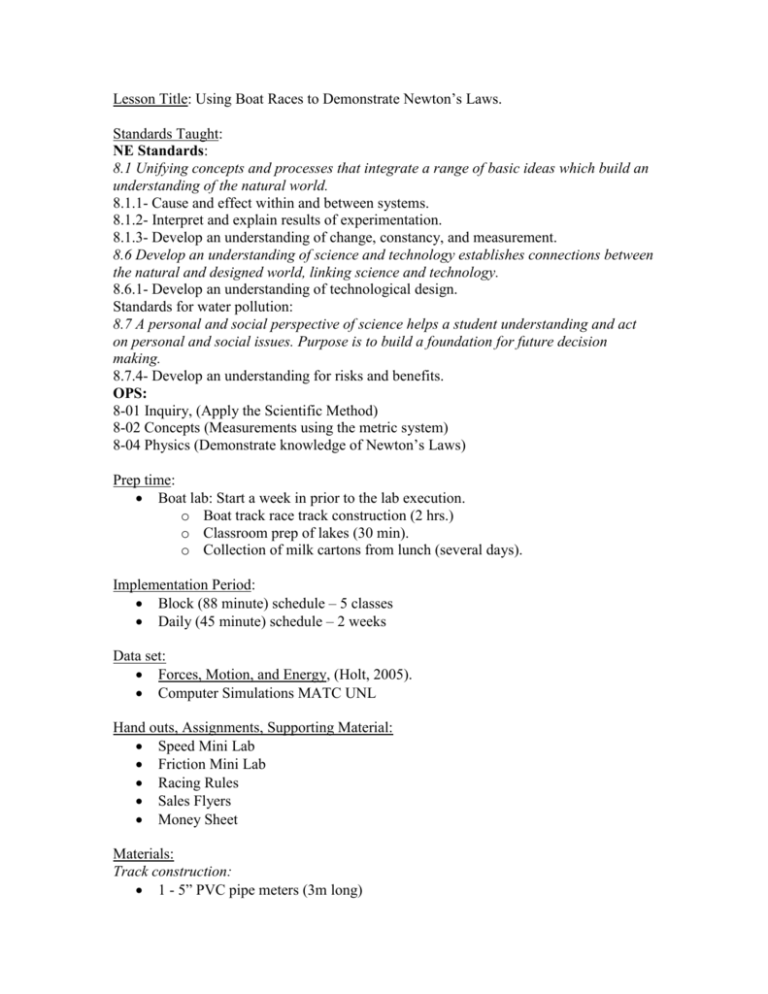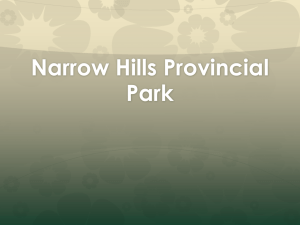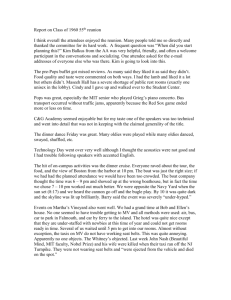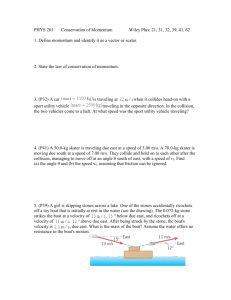Lesson title: Boat racing and nasty water
advertisement

Lesson Title: Using Boat Races to Demonstrate Newton’s Laws. Standards Taught: NE Standards: 8.1 Unifying concepts and processes that integrate a range of basic ideas which build an understanding of the natural world. 8.1.1- Cause and effect within and between systems. 8.1.2- Interpret and explain results of experimentation. 8.1.3- Develop an understanding of change, constancy, and measurement. 8.6 Develop an understanding of science and technology establishes connections between the natural and designed world, linking science and technology. 8.6.1- Develop an understanding of technological design. Standards for water pollution: 8.7 A personal and social perspective of science helps a student understanding and act on personal and social issues. Purpose is to build a foundation for future decision making. 8.7.4- Develop an understanding for risks and benefits. OPS: 8-01 Inquiry, (Apply the Scientific Method) 8-02 Concepts (Measurements using the metric system) 8-04 Physics (Demonstrate knowledge of Newton’s Laws) Prep time: Boat lab: Start a week in prior to the lab execution. o Boat track race track construction (2 hrs.) o Classroom prep of lakes (30 min). o Collection of milk cartons from lunch (several days). Implementation Period: Block (88 minute) schedule – 5 classes Daily (45 minute) schedule – 2 weeks Data set: Forces, Motion, and Energy, (Holt, 2005). Computer Simulations MATC UNL Hand outs, Assignments, Supporting Material: Speed Mini Lab Friction Mini Lab Racing Rules Sales Flyers Money Sheet Materials: Track construction: 1 - 5” PVC pipe meters (3m long) 2 - 5” PVC end caps. Pipe and caps needs to be split in half length-wise. Seal split end caps to pipe (halves) for no leaking. Boat supplies: Half pint milk cartons, cardboard or plastic will work. These cartons can be retrieved in the school cafeteria (one carton per lab group). 7” balloons Hot glue gun Masking tape Straight and bendable straws Scissors Single hole punch Sinks or Styrofoam coolers (for lakes) Craft sticks Rubber bands Side View Front View Top View Grade: 7th or 8th grade Plan of action: Students will create a balloon-powered, milk carton boat. Test runs boat in a “Public lakes.” Procedures (The following is based on 88 min. block) *Attention* This lab should be done AFTER a basic block of instruction on Newton’s Laws has been completed. A power point presentation is included for your convenience (see Newton’s Laws power point). 1st day: Have students independently read from their text information on Newton’s laws. Use power point to give notes on Newton’s Three Laws. 2nd day: Students conduct speed mini-lab. Students rotate through friction mini-lab. 3rd day: Inform students that they will be starting the boat lab, however; prior to starting the lab have students walk around room to observe filled sinks that will serve as our “Public lakes.” Have students observe the “Private lake race track.” This track will serve as the race track but, is pay to use only. (If sinks are unavailable for use as public lakes, large Styrofoam coolers will work well.) Have students’ record observations of, “Public lakes,” on a sheet of paper. Collect these papers for use AFTER boat lab is completed. (General observations should be that the lake waters are clean.) Hand out sales flyer and money. Students should receive a starting pay of $500. (Generally this is enough money but, you can use money how you see fit. Paying students for “…extra” work can be done as well, ie. classroom clean up.) Explain what the parts are that are listed on the sales flyer and the cost of those parts. Have students work in groups of two, students need to decide on a design of their boat and the cost. Have students draw out basic idea and add up final cost. Students use Boat Racing Simulation to test and modify their design. When completed they show the salesperson (teacher) their design and begin to purchase parts and build their boat. Have students test run boats on public lakes. When ready, students pay an entrance fee ($10) and test run their boat three times to find average speed (S=d/t) of their boat. 4th day: When all students have calculated their average boat speed (S=d/t) they then begin formal lab report. Students write up their formal lab report to address the problem, “How can my boat go faster?” Students create a hypothesis based on data collect from, test runs and knowledge gained from computer simulations, class notes, and text book readings. Experimental procedures indicate changes that need to be made. Re-test modified boat in public lake, pay for the test runs to calculate average speed. This data will be used for pairing for actual head to head race. (Create your own tournament bracket on an overhead sheet). 5th day: Students race against each other eventually leading up to Championship race. Create your own local rules or use the following “Big “K” Race track rules.” Upon completion of the boat lab hand back students pre-observations of the public lakes. Now have students move about to observe what the lakes look like after being used for the past week. (Water should look very polluted.) Have student write a post–observation about what they see. Guide discussion as to why the students think the water looks the way it does. Extension Use “Dirty water” as a launching point in to Environmental Science section. By using the “lakes” you can begin discussion of how water was polluted and how very few people cleaned lakes on their own. Ask students where in their environment have you witnessed this type of behavior? Evaluations, Assessments, and Grading Rubric: Located back on main website. Science and Math Implications: Students have to accurately use calculators for computing speed. Students apply scientific method to answer the question “How can I make my boat go faster?” Students use computer simulations to solve problems or refine boat designs. Students see the end results of over-use of natural resources. “Lake pollution.” Unexpected Results: >Students enjoyed seeing past winners and what their times were. (Posted as “Hall of Fame” in the classroom) >Use of money cut down on students asking the instructor questions, many students worked though their own problems or worked with other groups to find solutions. >Security of money and student boat material had to be tightened as “student equipment occasionally was jacked” in some classes. > Some boats tended to turn sideways and get caught on side of track. Those students had to answer a different problem on formal lab write-up. For these students the problem was, “How can I get my boat to go straight?” (Hint…boat needs equal force existing out the rear of boat…in a nutshell…dual exhaust is needed.)






